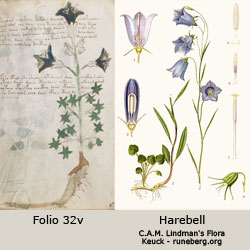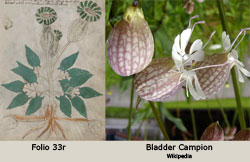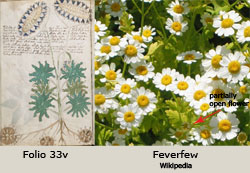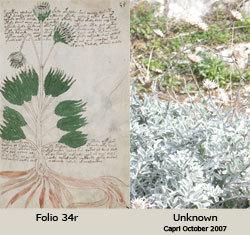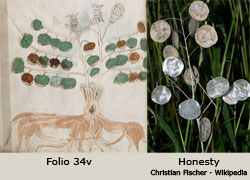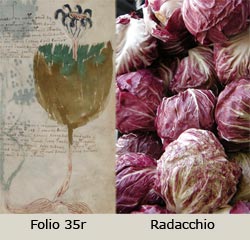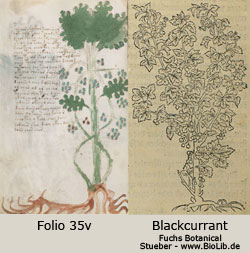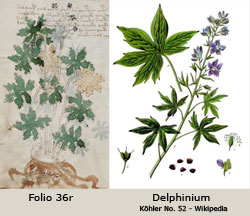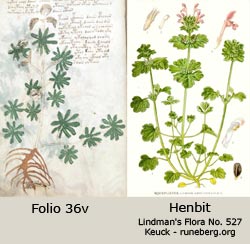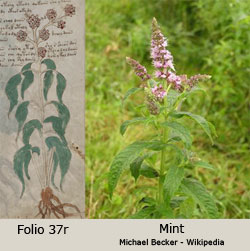The Voynich Botanical Plants
Folio 32v, Harebell (Campanula rotundifolia), is a common rhizomatous perennial found in Europe. The root leaves are dark-green, roundish, and usually slightly toothed. The long, thin stalks have thin-stalked, linear leaves and single or loose clusters of blue, bell-shaped flowers at their ends. The petal lobes are short and curve outwards. This plant is related to Rampion, Folio 4v.
Folio 33r, Bladder Campion (Silene vulgaris), is a common herb throughout Europe. The flowers are white with a balloon-shaped calyx. Its leaves are lanceolate and occur in pairs along the stem. This plant may be reproduced by seed or by rooting the short underground branches that slant outwards from the crown. Bladder campion is used as an emollient and its juice is used for treating conjunctivitis.
Folio 33v, Feverfew (Tanacetum parthenium), is a small shrub about 18 inches in height, originally native to the Balkan mountains of Eastern Europe, and now grown throughout Europe. This Folio is the VM “sunflower,” however the modern sunflower lacks many of the characteristics of the VM drawing. Feverfew has many daisy-like flowers that consist of an outer white ray and a disc of yellowish florets about 1 inch across, held in a dense corymb, similar to the flower shown in Folio 33v. The leaves are lobed or deeply toothed but not whorled. The plant spreads rapidly and will cover a wide area after a few years. Feverfew has been used for centuries in European folk medicine as a remedy for fevers, headaches, stomachaches, and toothaches. It is currently considered for the treatment of arthritis and migraine headaches.
Folio 34r. The identity of the comparison plant is unknown but may be Anemone hortensis, a species native to Italy. This rhizomatous plant has daisy-like flowers that occur in all shades between white and purple. It is distinguished by a rosette of three lobed divided leaves that grow at the base of the plant and another about half way up the stem. Anemones are no longer used as herbs but in the past various parts of the plant were recommended as cures for headaches and rheumatic gout.
Folio 34v, Honesty or Money plant (Lunaria annua), is a hairy-stemmed plant found throughout Europe. It is a member of the mustard family with a creeping rhyzome, erect stem, purple flowers with four petals, and pointed, coarsely serrated, oval leaves. The plant develops flat, round seed pods that turn a silvery, paper-like texture in the autumn; hence the common name money plant.
Folio 35r, Radicchio (Cichorium intybus, Asteraceae), may resemble a romaine lettuce, but it is a member of the chicory family. The cultivated plant has red leaves with white veins, a shallow root system and blue, daisy-like flowers. Cultivation of the plant began in Italy in the fifteenth century and the deep-red variety of today was engineered in 1860. Radicchio has been eaten as a vegetable since ancient times. Pliny the Elder claimed it was useful as a blood purifier and an aid against insomnia.
Folio 35v, Blackcurrant (Ribes nigrum), is native to Central and Northern Europe and is known in France as Cassis. It is a low growing shrub with alternate, palmately five-lobed leaves with serrated margins. The clusters of small, greenish-brown flowers produce edible, black, berry fruit in the fall that may be used to make jams and jellies. Blackcurrants are rich in vitamin C and are the basis of the children’s drink Ribena.
Folio 36r, Delphinium (Delphinium staphisagria), a member of the buttercup family, is native throughout the Northern Hemisphere. The plant has a fibrous root system, and deeply lobed leaves with 3 to 7 toothed, polinted lobes. The flowering stem is erect, topped with many purple, blue, red, yellow, or white five-petal flowers. All parts of the plant are poisonous, however the seeds have been used to treat parasites such as lice and nits in the hair.
Folio 36v, Henbit or Deadnettle (Lamium amplexicaule), is classified as a noxious weed. Its flowers appear in the early spring in warm areas like the Mediterranean countries. This annual has square hairy stems, opposite rounded leaves with lobed margins and pink to purple flowers. It closely resembles a stinging nettle but without the sting. The early shoots and leaves can be cooked and used as a green vegetable.
Folio 37r, Mint (Mentha longifolia), is found throughout Europe. It is a perennial plant that propagates through spreading rhizomes. The lance-shaped leaves are in opposite pairs along the erect branched stem that terminates in a spike made up of clusters of white to purple flowers. Mint leaves are used for teas, jellies, candy etc. Mint tea was given during the middle ages for stomach and chest pains.
